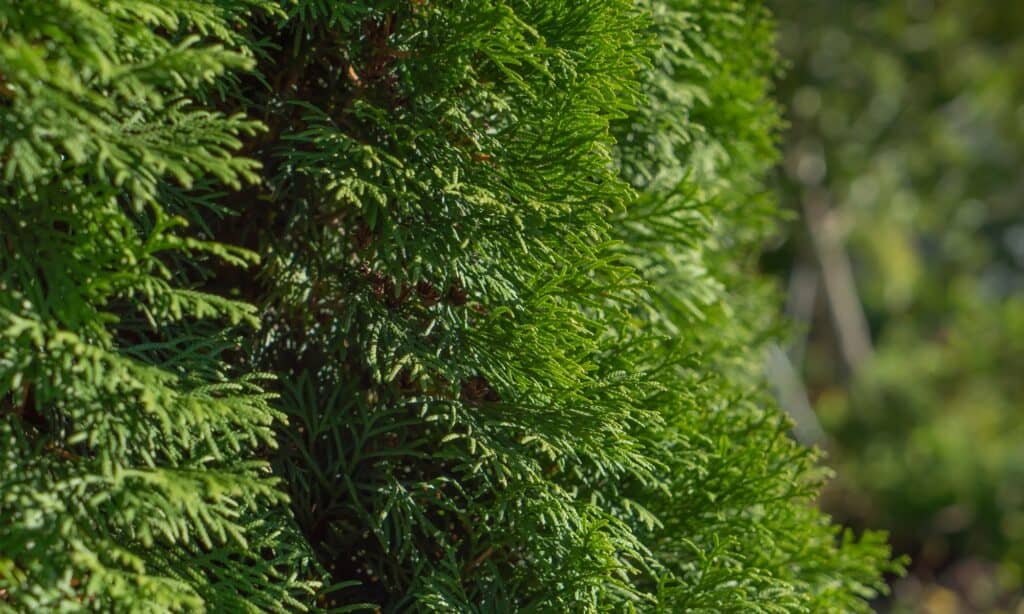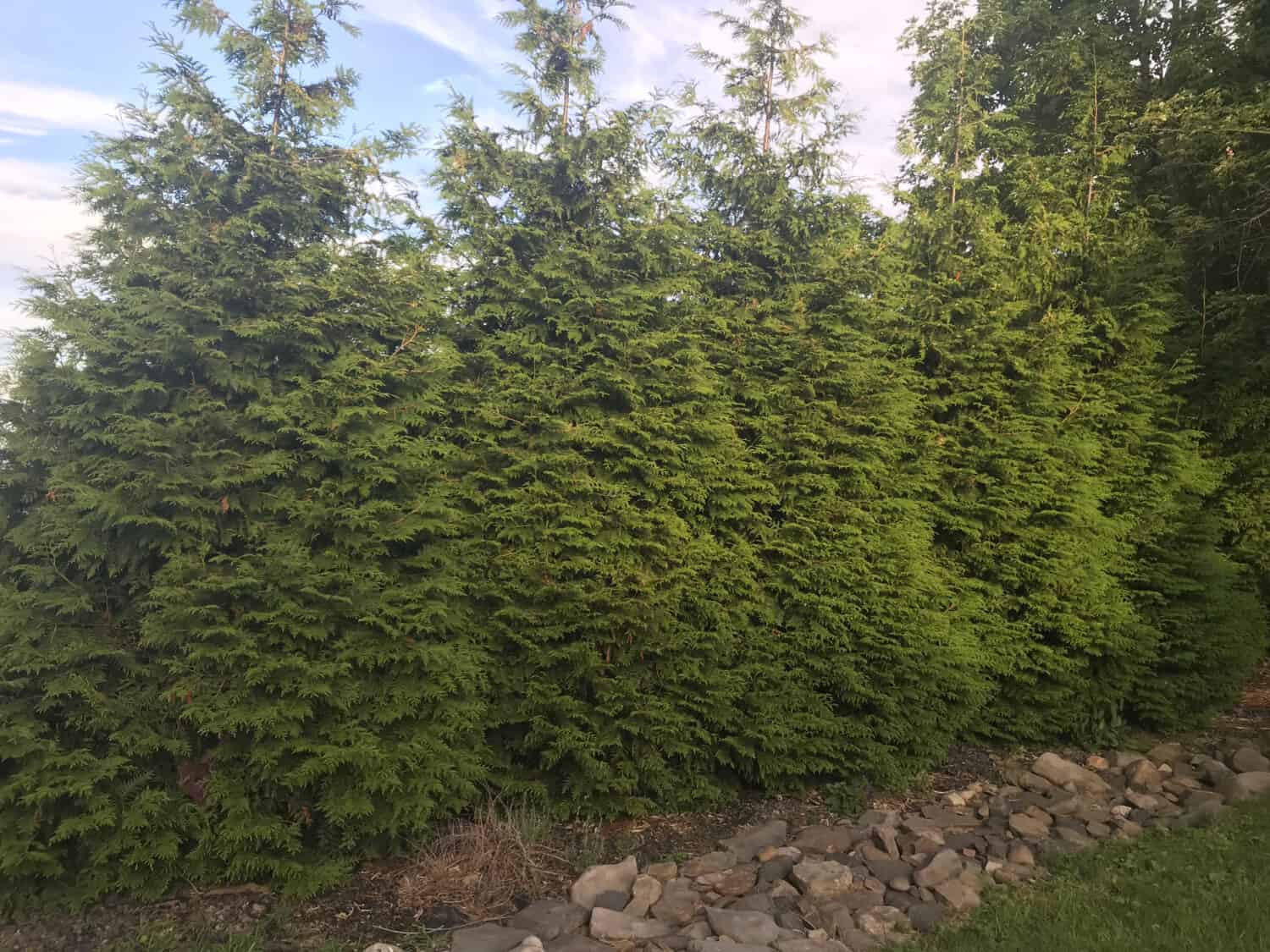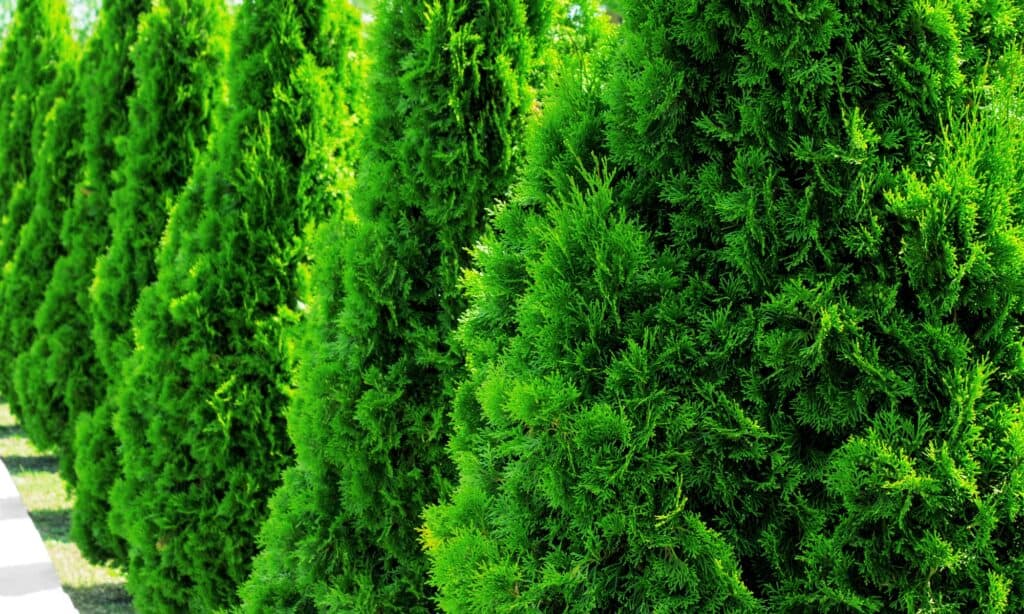Are you looking for a fast-growing evergreen tree to add privacy to your yard? Arborvitae trees are popular for homeowners due to their dense foliage and tall height. But with so many different types of arborvitaes, how do you know which one is right for you?
In this article, we’ll compare two popular types of arborvitaes: Steeplechase and Green Giant. We’ll look at their growth rates, foliage color, and overall appearance to help you decide which one to plant in your yard.
Steeplechase Arborvitae vs. Green Giant Arborvitae: Comparison
The Steeplechase Arborvitae and Green Giant Arborvitae belong to the same genus, Thuja (Latin term for “tree of life”), a member of the cypress family. However, they differ in their species and origin.
| Steeplechase Arborvitae | Green Giant Arborvitae | |
|---|---|---|
| Classification | Genus: Thuja Species: Thuja standishii × plicata ‘Steeplechase’ | Genus: Thuja Species: Thuja standishii × plicata ‘Green Giant’ |
| Origin | USA | Denmark |
| Physical Description | – Dense, pyramidal to a conical shape – Dark green color year-round | – Pyramidal to a conical shape – Bright green color in summer – Dark, bronzy hue in winter |
| Uses | Hedge, screen, windbreaker, noise resistant, drought tolerant | Hedge, screen, windbreaker, deer resistant, insect resistant, drought resistant, noise resistant |
| How to grow | – Grows 20 feet tall and 8 feet wide – Thrives in full to partial sun – Plant in fertile, well-drained soil – Ideal for smaller landscapes | – Grows 50 feet tall and 5 feet wide – More tolerant to heat and drought – Plant in fertile, well-drained soil – Ideal for larger landscapes |
Steeplechase Arborvitae vs. Green Giant Arborvitae: Classification and Origin
Steeplechase was discovered growing on a ‘Green Giant’ specimen by Alan Jones in 1990 in Felton, Pennsylvania. It was granted a Plant Patent (16,094) in 2004, which prohibits asexual reproduction during the life of the patent.
The Steeplechase Arborvitae is scientifically known as Thuja occidentalis ‘Steeplechase’ and is native to North America. It is a cultivar of the Eastern White Cedar and has a dense, conical shape, making it a popular choice for hedges and privacy screens. The Steeplechase can grow up to 20 feet tall and 8 feet wide, and its foliage is a rich, dark green color.
On the other hand, the Green Giant is a hybrid of Japanese Thuja (Thuja standish) and Western Redcedar (Thuja plicata), combined to create a hardy and fast-growing tree that can thrive across America. It remained unnoticed in Denmark in the 1930s until it was sent to the National Arboretum in Washington, D.C., in 1967.
The plant gained popularity in the 1990s and has since been widely planted for its versatility in gardens. It was named ‘Green Giant’ by a nurseryman from Tennessee and has since become popular in America.

Green Giant Arborvitaes work well in most backyard landscaping.
©iStock.com/IgorTsarev
Steeplechase Arborvitae vs. Green Giant Arborvitae: Physical Description
The Steeplechase Arborvitae is an attractive addition to any landscape due to its dense green foliage and pyramidal shape year-round. It’s an excellent choice for smaller landscapes as it has a faster growth rate, adding around 2 feet to its height each year. At maturity, it can reach up to 20 feet tall with a width of 8 feet.
Once established, this conifer is relatively drought-tolerant and can be used as a hedge, screen, or windbreak. It requires low maintenance and brings color to fall and winter gardens. The Steeplechase Arborvitae thrives in full to partial sun, but if planted in too shady of a location, it may lose some of its density and not reach its full potential.
The Green Giant Arborvitae has a pyramidal to conical shape with soft, feathery foliage and a bright, vibrant green color that takes on a slightly darker or bronzy hue in the winter. It can grow up to 50 feet tall and 5 feet wide, making it a great choice for larger landscaping projects.
In terms of hardiness, both trees are relatively easy to grow and maintain. Green Giants are ideal for planting in hardiness zones 5 to 7, whereas Steeplechase Arborvitae are ideal in hardiness zones 4-8.

Green giant arborvitae are versatile and durable trees that can tolerate high wind and snow.
©HudsonValleyNY/Shutterstock.com
Steeplechase Arborvitae vs. Green Giant Arborvitae: Uses
Steeplechase is beautiful with its lush green appearance and versatile in fulfilling different landscaping needs. It can be used as a hedging or screening plant to provide privacy, a windbreak, or to block noise. Its eye-catching appeal makes it a great choice to line driveways or walkways. It can also be used to accent plants with different colors and forms in mixed gardens, as a striking specimen, or to define a pond.
Additionally, its year-round green color makes it a perfect addition to areas that lack color during fall and winter. Steeplechase is a durable and hardy plant that can be used in various ways to enhance any landscape.
The Green Giant Arborvitae is a beautiful landscape tree that can be used as a screen, hedge, or standalone specimen. It’s also wind-resistant once mature and can tolerate heavy ice or snow loads, which makes it a great natural windbreak option.
In addition, Green Giants can resist most diseases, insects, and periodic droughts.
Steeplechase Arborvitae vs. Green Giant Arborvitae: How to Grow
When it comes to choosing between Steeplechase Arborvitae and Green Giant Arborvitae, there are a few things to keep in mind. Both trees are excellent choices for adding privacy and creating natural barriers, but they have some key differences in terms of how to grow them.
How to Grow Steeplechase Arborvitae
Steeplechase Arborvitae can withstand harsh winter conditions in planting zone 4, making it a great alternative to cypress for gardeners in that area. It also does well in warmer planting zone 8 but not in consistently warmer locations throughout the year.
Steeplechase Arborvitae is low-maintenance and adapts quickly to its planting site, but it may need extra watering during hot, dry summers.
Avoid planting in too much shade, which can lead to decreased density and poor thriving. Consider adjusting your soil with compost or manure to boost nutrient levels before planting.
When planting multiple Steeplechase Arborvitae, space them according to their mature width, allowing air circulation to prevent disease. Steeplechase Arborvitae is generally drought-tolerant after the first season.
How to grow Steeplechase Arborvitae tips:
- For optimal growth and density, plant in full or partial sun
- Plant in fertile, well-drained soil
- Water regularly during the root establishment period and hot, dry conditions

Green Giant Arborvitae trees have soft, feathery, green foliage.
©iStock.com/Mykola Sosiukin
How to Grow Green Giant Arborvitae
Green Giants are a low-maintenance landscaping option due to their hardiness, requiring little to no pruning to maintain their shape. For diversity and disease prevention, planting a group of three Green Giant arborvitae and mixing them with other screening trees is recommended.
Planting Green Giant Arborvitae during spring provides ample time for plants to establish their roots and grow optimally. In contrast, planting during the fall or winter may not result in immediate growth. However, it can still be advantageous for future growth during warmer seasons due to continued root development underground.
How to grow Green Giant Arborvitae tips:
- Plant in all soil types
- Plant in full sun or partial shade
- Plant in fertile, well-drained soil
- It’s very salt sensitive
Final Thoughts
The Steeplechase Arborvitae and Green Giant Arborvitae are both excellent choices for adding greenery to your landscape. While the Steeplechase is a fast-growing tree that can reach up to 2 feet per year and features small, glossy green leaves and tiny oblong cones, the Green Giant is a more resilient option that resists most diseases, insects, droughts, and deer. Both trees are low-maintenance and can be used in various ways to bring life to your property.
The photo featured at the top of this post is © iStock.com/Mykola Sosiukin
Thank you for reading! Have some feedback for us? Contact the AZ Animals editorial team.






